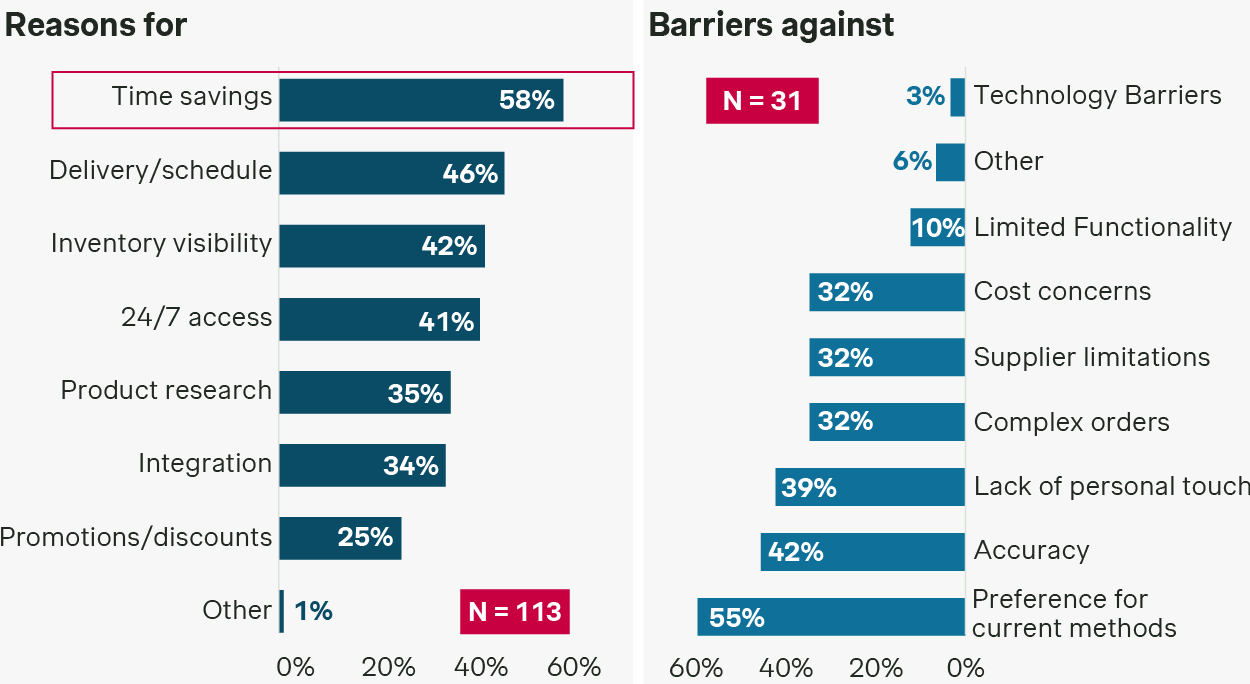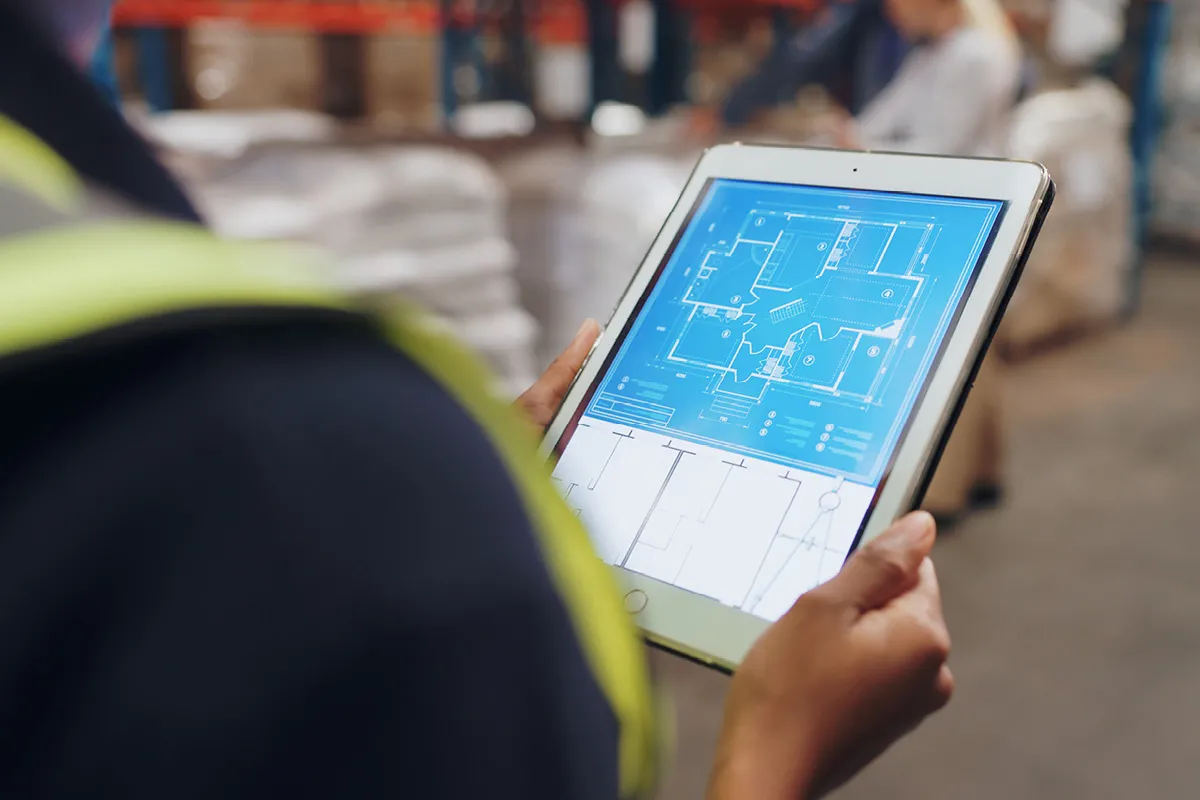While the construction industry hasn’t traditionally been seen as a frontrunner in digital transformation, that perception is changing quickly as purchasing preferences evolve. Today, most builders and contractors aren’t just open to buying materials online, they already are. In fact, from our latest construction and building materials study, over 80% of builders and contractors say they purchase online at least occasionally, and by 2030, nearly half of all building material purchases are expected to transact through digital channels.
For suppliers and distributors, this channel shift isn’t just coming, it’s already here. In a space where trust, relationships, and in-person service have long been the cornerstones of doing business, those who manage to translate that same level of connection into digital channels will be the ones who outpace their competitors.
Why digital transformation in construction has hit a tipping point
Digital adoption in this industry isn’t about replacing people or eliminating service, it’s removing friction from the buying process, speeding up transactions, and delivering the same trusted service with greater convenience. Our study found that time savings is the number one reason builders and contractors prefer to order materials online. But it’s also more than that. Digital sourcing helps with scheduling, inventory visibility, and product research.

However, that doesn’t mean the in-person side of the business is going away. Contractors still want to know their local rep is just a call away. Builders still expect quick answers when timelines shift. That’s why the move to digital shouldn’t be either/or, it has to be both. The right omnichannel strategy combines convenience with the high-touch experience your customers trust and expect.
Pain points: what’s holding back digital adoption?
Unfortunately, not every digital experience is seamless. Many suppliers have a website and maybe even some eCommerce functionality, but they often fall short. Builders and contractors still have legitimate concerns:
- Complex orders that aren’t easily captured through standard online workflows
- Inventory data that’s often unreliable or out of sync
- Limited live support when problems arise or decisions need quick input
- Cumbersome interfaces that feel more like form-filling than using a truly helpful tool
Our survey findings also echo these frustrations. Builders and contractors emphasized that lack of reliable inventory data and poor customer service are key obstacles that push them back to traditional purchasing channels.
That’s what we mean when we say digital isn’t optional anymore; it has to work. If your platform adds friction instead of removing it, buyers will default to phone calls, local relationships, or worse, turn to competitors who’ve mastered their omnichannel strategy.
A modern omnichannel strategy: what it really looks like
Getting digital right doesn’t mean launching a fancy app overnight. It means making every touchpoint, online or off, feel connected, easy, and valuable. Here’s what that looks like:
- Accurate, real-time inventory that reflects what’s actually available
- Account-specific pricing and quoting that mirror the relationships you’ve built, not just generic storefront listings
- Instant access to help, whether through live chat or click-to-call support, exactly when buyers need it
- Smart reordering tools that remember past purchases and simplify repeat buys
- Mobile-first interfaces designed to work from the jobsite, not just from behind a desk
Survey data underscores this need for integration. Builders and contractors are still loyal to suppliers who offer reliable service and trustworthy relationships, even as they increasingly go digital.
This isn’t about creating a tech company experience; it’s about saving your customers time, earning their repeat business, and keeping your reps focused on higher-value work instead of chasing down order statuses.
The business case: why it’s worth the effort
The payoff here isn’t just theoretical. According to our research, one large distributor saw gross margins on digital orders that were 100 basis points higher than traditional ones. That’s a full percentage point back to the bottom line, just by making it easier for customers to place orders.
But it’s not just about margins. A better digital experience also creates more opportunities to understand what your customers are browsing, quoting, and prioritizing, giving your sales team a smarter starting point. And when you can tailor recommendations based on that behavior, your upsell and cross-sell potential grows.
These factors highlight why a digital strategy can’t just be about the buying interface, it also has to highlight and differentiate the features your customers care about most.
How to start: taking the first step toward smarter digital
You don’t need to overhaul everything tomorrow. Start with the biggest friction points in your buyers’ current journey. What do they complain about? What still feels too manual? What makes them pick up the phone instead of ordering online?
Here’s how to begin:
- Pilot improvements with a few key customer segments
- Match digital tools with real people, don’t let service feel like an afterthought
- Make it easy to gather feedback and iterate quickly
- Prioritize mobile-first experiences; builders and contractors are often working from the jobsite, not a desk
Digital transformation can feel overwhelming, but you don’t have to tackle it all at once. What matters most is taking the first step, and making it count.
Our findings say: it’s not digital vs. traditional, it’s both
The best customer experience is flexible. Whether someone orders online or calls their local rep, it should just work. Digital is clearly where the industry is headed, but keep in mind that the basics, trust, service, and reliability, still matter. The suppliers who can deliver on both fronts are the ones who’ll stay competitive.
We’d love to help you build a digital strategy that works for your customers and for your bottom line. Contact our team today.








